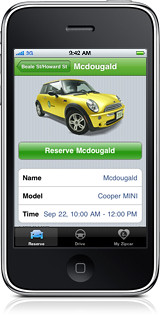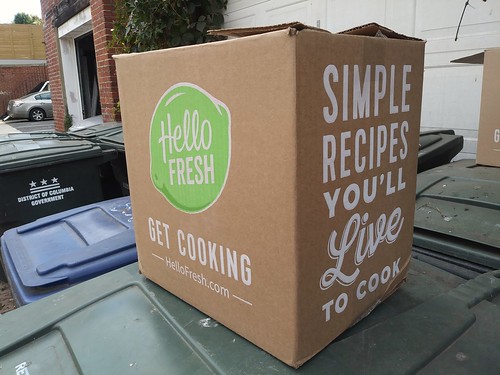I finally figured out why mobility services are buying other mobility services: they're acquiring customers already familiar with smart mobility
For some time, I have been somewhat skeptical of the talk that autonomous vehicles are going to change everything--well, they may, but it will be a couple decades happening--or that people will willingly shift from buying cars to "subscribing to a program like Whip which will cover the bulk of their mobility needs across different modes by paying a monthly subscription.
The reason I am skeptical about autonomous vehicles and the talk of it and mobility as a service "revolutionizing" the industry, at least in the short and intermediate terms, is that the move to mobility as a service is only really happening in big cities, and even so, most big cities aren't well positioned to prioritize and preference sustainable mobility/MaaS.
 Car sharing as an indicator of demand for smart mobility services. Note for a long time I've argued that car sharing is a good analogue for mobility as a service. It's a growing business, but still niche. From the 2015 Auto Rental News article "Carsharing: State of the Market and Growth Potential":
Car sharing as an indicator of demand for smart mobility services. Note for a long time I've argued that car sharing is a good analogue for mobility as a service. It's a growing business, but still niche. From the 2015 Auto Rental News article "Carsharing: State of the Market and Growth Potential":Compared to car rental, total fleet size and revenues for carsharing remain relatively small. The “Fall 2014 Carsharing Outlook,” produced by the Transportation Sustainability Research Center at the University of California, Berkeley, reports 19,115 carsharing cars in the U.S., shared by about 996,000 members. Total annual revenue for carsharing in the U.S. is about $400 million, compared to the $24 billion in revenue for the traditional car rental market.That's not a huge market. But makes a great deal of difference in city centers. But given that most people live in the suburbs, it's a small segment of the market.
Those carshare numbers have roughly doubled in five or six years, demonstrating steady growth but not an explosion. Yet technology, new transportation models, shifting demographics and changing attitudes on mobility present new opportunities. Is carsharing poised to take advantage?
DC as a smart mobility leader. DC is and in fact has been a leader, at least in North America, when it comes to smart mobility/MaaS, even if the system is being developed more incrementally and less purposively.
As an early adopter of such services (transit, car sharing--not ride hailing and I don't need to use bike share because I am a hard core cyclist) I believe I have a decent sense for how the sustainable mobility platform is being constructed.
-- "Further updates to the Sustainability Mobility Platform Framework"
-- "DC's framework for Mobility as a Service" (to come)
Direct marketing as an education in product development and delivery. My first job in DC was for a consumer group, but on the publishing side, not advocacy. The organization published a newsletter and books, which provided the bulk of the organization's revenue. Over time, I ended up with a pretty good education in direct marketing, which turns out to be a good basis for understanding most types of marketing, especially e-commerce.
Customer acquisition is expensive. With newsletter publishing, you did "direct mail" to acquire customers and it could be 2-4 years before the revenue from each new "member" began to pay off the original cost of "acquiring the customer."
Acquiring a customer, and keeping them as an active customer, is an expensive process.
In terms of customer profitability, there is the famous 80/20 rule, that 80% of a company's revenue comes from 20% of its customers--it's best customers.
Or in banking, the more lines of business a customer has (checking account, savings account, mortgage, brokerage, etc.) the more profitable the customer is to the bank, etc.
"Market development," selling a new type of product and building a customer base for it, is expensive, takes a long time, and sometimes may not ever be successful. There are lots of good ideas, but sometimes even good ideas are hard to develop into a profitable business (despite what Silicon Valley venture capitalists lead us to believe).
 Meal kit industry. In the meal kit industry it was discovered that the cost of acquiring a customer was particularly high, but some firms were better (Blue Apron) than others (Hello Fresh) at keeping customers buying for longer, although most have finally figured out that the business doesn't make a lot of economic sense, so they are shifting to having meal kits sold at the supermarket.
Meal kit industry. In the meal kit industry it was discovered that the cost of acquiring a customer was particularly high, but some firms were better (Blue Apron) than others (Hello Fresh) at keeping customers buying for longer, although most have finally figured out that the business doesn't make a lot of economic sense, so they are shifting to having meal kits sold at the supermarket.Safeway bought Plated, Kroger bought Home Chef ("How Kroger bought Home Chef," Cincinnati Business Courier), etc.
It's expensive to get customers for products people already are familiar with, like newsletters and magazines, or food.
It's even more expensive to get customers for products that people aren't familiar with. People understand buying and owning a car. They don't understand car share, or subscribing to a "shared taxi" service like Via.
For awhile Enterprise Car Share ran some tv ads that I thought were pretty good, explaining car share, but they stopped doing so a long time ago. The ads aren't even available on youtube anymore. Zipcar has youtube ads, but I'm not sure I ever saw them on tv.
Vertical integration in the Smart Mobility Biz. This repositioning of the meal kit industry is comparable to what seems to be happening in the "Mobility as a Service" industry. Horizontal integration is buying or merging similar firms. For example, recently, BMW and Mercedes merged their carsharing operations. Or Kroger bought Harris-Teeter.
Vertical integration is extending your business into other elements of the value chain and industry, like Kroger buying Home Chef or the online bulk grocery sales outfit Vitacost.
A few months back, Uber, the ridehailing firm, bought Jump, a dockless e-bike sharing operation. Last week, Lyft, a ride hailing firm, bought Motivate, an operator of bike sharing systems. This week, Uber set up a strategic relationship with LimeBike to cross-sell dockless e-scooter services.
Smart mobility firms are doing "vertical integration" in order to cross-sell different mobility services to customers already familiar with and experienced in buying smart mobility services, be it transit, ride hailing, bike share, or car share.
And already, established companies like Ford, GM, Mercedes, BMW are operating in various MaaS sectors such as car sharing or microtransit. In The SF Bay area, Ford is the title sponsor for the dock-based bike sharing program ("Ford Motor Company as a transportation company not a "car" company: bike share and small scale transit"), etc.
Operating across multiple lines of business = a transportation company. Although they're likely to tell us they are doing this because they are "transportation companies" a la the discussion by marketing professor Ted Levitt, which I referenced in "Ford Motor Company as a transportation company not a "car" company: bike share and small scale transit" (2016)
From "Marketing Myopia" reprinted in the Harvard Business Review, "What Business Are You In?: Classic Advice from Theodore Levitt," 2006:
Every major industry was once a growth industry. But some that are now riding a wave of growth enthusiasm are very much in the shadow of decline. Others that are thought of as seasoned growth industries have actually stopped growing. In every case, the reason growth is threatened, slowed, or stopped is not because the market is saturated. It is because there has been a failure of management….What's going on in the MaaS field with acquisitions
The railroads did not stop growing because the need for passenger and freight transportation declined. That grew. The railroads are in trouble today not because that need was filled by others (cars, trucks, airplanes, and even telephones) but because it was not filled by the railroads themselves. They let others take customers away from them because they assumed themselves to be in the railroad business rather than in the transportation business. The reason they defined their industry incorrectly was that they were railroad oriented instead of transportation oriented; they were product oriented instead of customer oriented….
1. I think there is a recognition that there are only so many "customers" familiar with and willing to use "smart mobility services."
2. Rather than spend tons more money in market development, they think they can make more money now by selling more services to people who are already familiar with these types of services.
In marketing terms, it's a form of both (1) cross-selling -- just like the banks selling home insurance to a mortgage holder and a mortgage to a checking account holder, and (2) line extension -- French's mustard never made ketchup but they realized they could do so successfully by leveraging the French's brand, Heinz did the same with mayonnaise.
3. And so they are buying firms in related lines of business.
That being said, owning Zipcar hasn't made Avis a more successful car rental company. Will people who like feeling they are driven by a chauffeur (Uber) want to sit on and ride an e-bike?
4. The next step is to first figure out how to cross-sell services--ride hailing to bike share users, or e-scooter use to bike share, or bike share to microtransit users, etc.--to an already knowledgeable customer base and then if they can make money doing so.
5. And then they might start focusing again on making the pie larger through market development.
Labels: mobility as a service (MaaS), sustainable mobility platform, sustainable transportation, transit infrastructure, transportation as a service (TaaS), transportation planning, urban design/placemaking



3 Comments:
I'm sure you already read this:
https://stratechery.com/topic/transportation/ride-sharing/
But your basic point (customer acquisition) is spot on.
I was going through something on millennial spending habit in london (maybe BI) and "transport" was #2 on the list. car payments were something like #10.
nope, missed that, thanks. will read.
yes, in cities with great transit, that is priced as a utility, people spend much less on mobility, compared to typical US households that are car dependent that spend an average of 14%.
https://www.valuepenguin.com/average-household-budget
... during the post crash period, Harriet Tregoning kept making the point that people who didn't have to own a car had more money to spend on other things, including a mortgage.
====
while writing this piece also wrote more than half of the DC MaaS piece but I will continue to tinker with it over the weekend and publish for Monday.
https://www.theguardian.com/technology/2018/aug/27/uber-to-diversify-into-electric-bikes-and-scooters-to-drive-growth
Uber is to switch its focus from taxis to electric bikes and scooters to grow its global business, its chief executive has said.
The ride-hailing app will promote different modes of transport that can work better in congested inner cities, to keep Uber users on its platform.
Dara Khosrowshahi told the Financial Times (paywall) that while the move would cost Uber in the short term, in the long term it would be better for cities, users and the company.
He said: “During rush-hour, it is very inefficient for a one-ton hulk of metal to take one person 10 blocks.”
Khosrowshahi said that diversifying would help shape user behaviour and also allow Uber to grab more of a “$6tn (£4.7tn) mobility market”, adding: “No one product is going to be serving that whole market.”
Post a Comment
<< Home